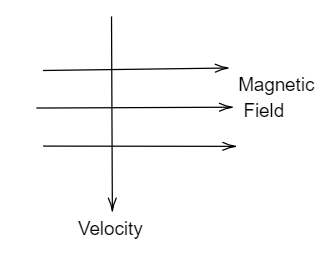
A charged particle enters at right angles into a uniform magnetic field as shown What should be the nature of the charge on the particle if it begins to move in a direction pointing vertically out of the page due to its interaction with the magnetic field?


Answer
551.4k+ views
Hint:Lorentz force is the force acting on a charge which is moving with a non-zero velocity in a magnetic field such that the direction of the magnetic field and velocity vector is not in the same direction. The direction of this Lorentz force is obtained using the right-hand palm rule.
Formula used:
$\overrightarrow F = q(\overrightarrow v \times \overrightarrow B )$
where $\overrightarrow F $ is the magnetic force or the Lorentz force vector acting on the charged particle,
$q$ is the magnitude of charge which is moving with velocity $\overrightarrow v $ in a magnetic field $\overrightarrow B $.
Complete answer:
We want that the particle must move in a direction pointing vertically out of the page so the force acting on that particle must also be in the same direction.
We know that,
$\overrightarrow F = q(\overrightarrow v \times \overrightarrow B )$
where $\overrightarrow F $is the magnetic force or the Lorentz force vector acting on the charged particle,
$q$is the magnitude of charge which is moving with velocity$\overrightarrow v $ in a magnetic field $\overrightarrow B $.
So from the figure given in the question, the above-stated formula, and the right-hand palm rule we can say that,
The force acting on the particle is in the direction pointing vertically out of the page only when the particle is positively charged or else it will be in the direction pointing vertically inside the page.
Hence the correct answer to the above question is positively charged.
Note:
Lorentz force doesn’t do any work on the charge so it doesn’t impart any power to it. Lorentz force does not act on a particle at rest and it also does not act on neutral bodies. It is perpendicular to the plane containing the magnetic field vector and velocity vector.
Formula used:
$\overrightarrow F = q(\overrightarrow v \times \overrightarrow B )$
where $\overrightarrow F $ is the magnetic force or the Lorentz force vector acting on the charged particle,
$q$ is the magnitude of charge which is moving with velocity $\overrightarrow v $ in a magnetic field $\overrightarrow B $.
Complete answer:
We want that the particle must move in a direction pointing vertically out of the page so the force acting on that particle must also be in the same direction.
We know that,
$\overrightarrow F = q(\overrightarrow v \times \overrightarrow B )$
where $\overrightarrow F $is the magnetic force or the Lorentz force vector acting on the charged particle,
$q$is the magnitude of charge which is moving with velocity$\overrightarrow v $ in a magnetic field $\overrightarrow B $.
So from the figure given in the question, the above-stated formula, and the right-hand palm rule we can say that,
The force acting on the particle is in the direction pointing vertically out of the page only when the particle is positively charged or else it will be in the direction pointing vertically inside the page.
Hence the correct answer to the above question is positively charged.
Note:
Lorentz force doesn’t do any work on the charge so it doesn’t impart any power to it. Lorentz force does not act on a particle at rest and it also does not act on neutral bodies. It is perpendicular to the plane containing the magnetic field vector and velocity vector.
Recently Updated Pages
Master Class 12 Business Studies: Engaging Questions & Answers for Success

Master Class 12 Economics: Engaging Questions & Answers for Success

Master Class 12 English: Engaging Questions & Answers for Success

Master Class 12 Maths: Engaging Questions & Answers for Success

Master Class 12 Social Science: Engaging Questions & Answers for Success

Master Class 12 Chemistry: Engaging Questions & Answers for Success

Trending doubts
What is meant by exothermic and endothermic reactions class 11 chemistry CBSE

Which animal has three hearts class 11 biology CBSE

10 examples of friction in our daily life

One Metric ton is equal to kg A 10000 B 1000 C 100 class 11 physics CBSE

1 Quintal is equal to a 110 kg b 10 kg c 100kg d 1000 class 11 physics CBSE

Difference Between Prokaryotic Cells and Eukaryotic Cells




